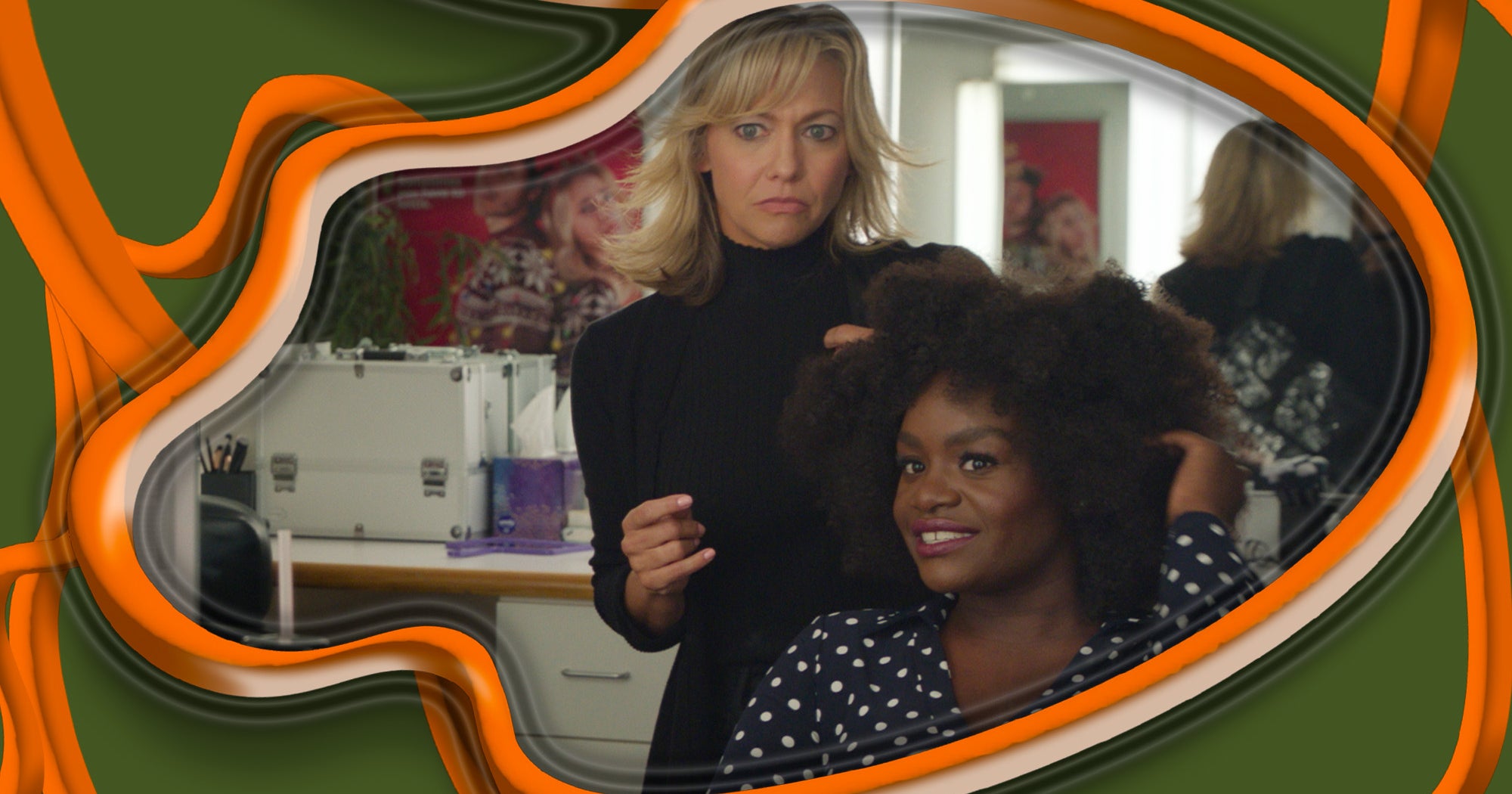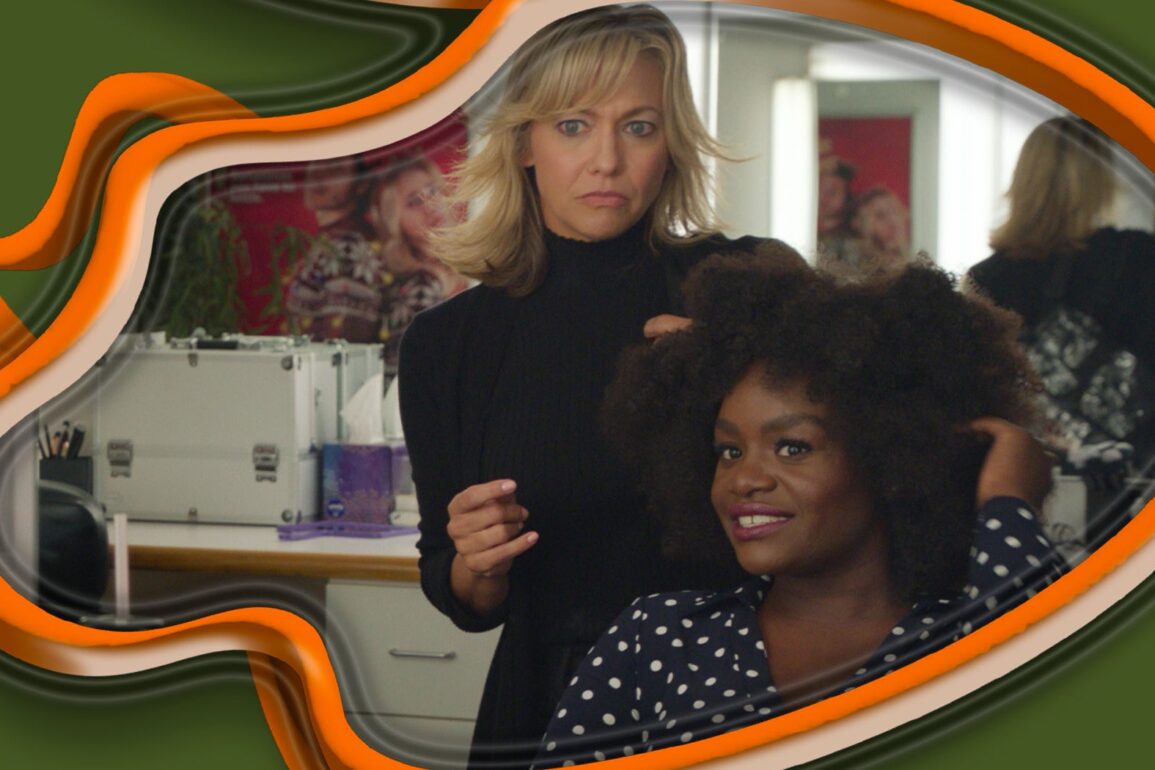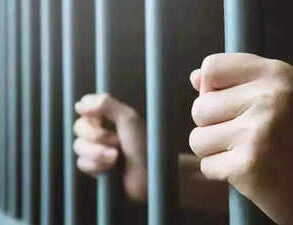
In 2019, Refinery29 posted an article called Black Actors Are Getting Huge Roles In Hollywood, But Still Doing Their Own Hair outlining the “terrifying and high-anxiety” inducing reality of actors sitting in trailers on sets with artists unfamiliar with doing Black hair and makeup. That year, other Black actresses, including Natasha Rothwell, Yvette Nicole Brown, and Gabrielle Union, took to Twitter (now X) to discuss H&MU horror stories using the hashtag #ActingWhileBlack. A year later, Kat Graham went viral when she broke down crying during a video for Vogue about having to hide her natural hair for every role she had ever played (including The Vampire Diaries). “One day I wish I can play a character that I actually look like,” she said through tears. When I interviewed You star Shalita Grant in 2021, she talked about starting her own natural hair care line because her 4C hair was ruined on the set of NCIS: New Orleans. “They were committed to me hiding my natural hair, even though a curlier texture would have made a lot more sense in New Orleans,” she told me. “We were literally spending hours in the trailer to try to make my hair something that it wasn’t… when I left that show, I had a bald spot in the center of my head.” Graham went viral again just last year when she got emotional in makeup pro Danessa Myricks’ chair because she was finally working with a Black artist. And earlier this year, Academy-Award winner Da’Vine Joy Randolph told me she had to fight “tooth and nail” for authentic Black hair and makeup in The Holdovers.
That’s five years worth of stories from Black women in Hollywood who should have been able to focus on doing their jobs instead of dealing with incompetent hair and makeup artists who weren’t doing theirs — and there are so many more. These anecdotes have become so prolific, hair discrimination on set was a key discussion point during the recent SAG-AFTRA strike culminating in a hair and makeup subsection of the new agreement that mandates better working conditions for actors with textured hair and of all skin tones. Now, it’s on the studios and networks to make the necessary changes so that these infuriating experiences from Black talent don’t continue. The Black Beauty Roster is making sure a new standard is set and their collaboration with NBCUniversal Launch (which predates the strikes) is a great example that others in the industry should follow.
What Is Black Beauty Roster?
“At BBR, our mission is to ensure that we’re bringing more meaningful and intentional diversity into the industry, especially in the entertainment and beauty industry,” Maude Okrah, the CEO and founder of Black Beauty Roster (BBR), tells me over Zoom. Founded in 2020, after the so-called “racial reckoning” when the world seemed to be waking up to the realities that Black folks face in the workplace, Okrah saw the moment as a chance to do something substantial, instead of just talk about it. “I’m sure we all saw the tweets, read the articles, and heard the stories of talent and performers crying in their trailers, feeling as though they can’t speak up,” Okrah says. “2020 really caused a number of us to just sit and reflect and say, what more can we do?” What Okrah decided to do is create a diversity and inclusion platform that connects skilled beauty professionals with the industries who need them (TV and film, fashion, commercials) — on and off set — and provide education to the executives in hiring positions and decision makers with the power to change how sets are run. That’s how BBR was born, and now, it’s providing real solutions to one of the industry’s most preventable problems.
When it comes to the lack of diversity on sets, especially behind the camera, a common excuse used is “well, we just couldn’t find the talent!” perpetuating the myth that the only capable people in the entire industry are white. Well, that excuse doesn’t track anymore when BBR exists. Through the BBR portal, brands (along with NBC, BBR works with L’Oréal Groupe, Spotify, and IMG, just to name a few) are able to tap into the roster of talent in a centralized destination for their diverse hair and makeup needs, whether it be for on-set work, film premieres, press tours, photoshoots or more. “Our carefully vetted network of beauty professionals represent the epitome of skill and artistry. They possess an innate understanding of the intricacies that make each individual beautiful in their own right,” The Black Beauty Roster website reads. “From mastering the art of blending to embracing the richness of diverse hair textures, they create beautiful moments that leave an indelible mark.”
You would think that with a resource like this, hair discrimination on sets would be a thing of the past, but there are still countless examples from actors who have had bad experiences. Just last month, Bridgerton star Golda Rosheuvel (she plays Queen Charlotte) told me that her first meeting with the show’s makeup and hair designer, Erika Ökvist, made her cry. “It was the first time that I had been in conversation with a head of a department of that caliber — or anybody — discussing the fact that she was going to incorporate my own hair into the looks and that it was very important for her to deal with different Black textures to really celebrate my Blackness,” Rosheuvel said.
Black Beauty Roster’s mission is to make sure every head of a department has this knowledge and motivation to celebrate different hair textures. And a key part of their partnership with NBCU is training executives, department managers, and people in power so they don’t contribute to environments making actresses cry before anyone calls “action!”
It Starts With Education
When I get on a Zoom call with Okrah and Jeanne Mau, Senior Vice President, TV Programming Diversity, Equity and Inclusion at NBCUniversal, they have generously offered to take me through BBR and NBCU’s partnership and specifically, what a training session for executives looks like. “The educational piece that has been such a game changer in our business,” Mau says of the first-of-its-kind training was developed in collaboration with BBR, licensed psychologists and industry experts. The diverse hair and makeup allyship training is provided for NBCU’s senior-level decision makers in creative and production and covers a range of topics — from the history of makeup in TV and film for important context to nuanced education on textured hair and makeup application techniques.
The training also delves deep into the impact improper treatment of hair and makeup can have on a performer’s emotional health. If a Black actress is worrying about her hair taking twice as long as the time allotted (and that after all that it’s still going to look a mess) or about the makeup artist having the right shade, she’s stressing over things her white counterparts don’t have to. This could impact her preparedness for the day of work ahead and ultimately impact the production as a whole. One of the biggest concerns that led to this partnership, Mau says, was “How do we thoughtfully and authentically think about [timing] when we put somebody in hair and makeup? And how do we afford the show the proper amount of time to get it right?” She continues, “There are issues regarding hiring the right person for hair and makeup, but more importantly, how do we ensure that whoever is sitting in the chair is afforded the proper amount of time to do what needs to be done for him or her to show up on set and do their job?”
This is what makes this training so unique. Often, the focus is on talent in front of the camera and the hair and makeup people in the trailers. But you can have all those key ingredients and still be subject to a system set up for you to fail. If you don’t give Black artists the proper time and they run over, talent is immediately labeled a “diva” or the H&MU technician is branded as unprofessional. The problem has been that at the highest levels, executives have no idea how long this essential part of the business takes, or what it entails. “What made me take a step back and pause was I realized that a lot of people want to do the right thing, but they’re not sure exactly what to do,” Okrah explains to me during the training session. “And that became why education was such a huge pillar for us in the work that we’re doing.” The progress that has been made in the industry over the years has resulted in more Black talent in front of and behind the camera, but now it’s time to ensure that those creatives are supported and protected. Education is the first step.
“We’re telling stories that look like the communities we live and work in for the first time, in some instances, and especially over the course of the last 10 years,” Okrah says. “But one of the questions we’ve asked is, ‘how are we diversifying behind the camera, and are we diversifying as fast as we are diversifying in front of the camera to ensure that talent is supported?’”
Part of the lack of support and understanding comes from unconscious bias and, frankly, ignorance to the complexity of Black hair and its history. In the training, “we talk a little bit more on important moments in textured hair,” Okrah says. “From telling the story of what made the Black community feel the need to start straightening their hair going as far back as the 1900s. Then [we go through] the evolution that you saw in the ‘60s and ‘70s, where Black women especially embraced their natural hair, and how that was viewed as a means of rebellion.”
Okrah’s training then takes us to the 1980s — jheri curls, relaxers, and all — and all the way to the Crown Act. “If you’re going to advocate a champion, you have a little bit more of an understanding of the historical context and why this work is so important,” Okrah explains.
From there, we get into the science of it all. The training goes deep into understanding the differences of textured hair, like round follicles vs. oval follicles, and different hair types, plus consistency and maintenance. “When we’re talking about Black talent, we’re looked at as a monolith — all the same shade, shade texture,” Okrah says. The BBR hair type guide leans into the diversity of Black hair and differentiates between straight, wavy, curly, very curly, kinky, and coily to help executives with the language component of Black hair. Yes, white television executives are sitting through training sessions (Okrah confirmed that the majority of the execs who have taken the training have been white) about how long it takes to maintain 4C hair — and, according to Mau, they’ve been more than receptive.
“[There have been] aha and wow moments that have been taken away because of the education now affording our creative executives an opportunity to sit with the idea that they can hire the right hair and makeup person, but they also have to think about, ‘what does our call sheet look like?’” Mau says. I’m a little more skeptical about the ahas and the wows because if you don’t know by now the basics of Black hair or the struggles that talent go through, should you be in a position of power at a studio or a network? Ignorance isn’t bliss when it comes to the gatekeepers of Hollywood. But Mau and Okrah agree that diversifying the executive level is also a key component to this quest for a better industry.
Who Benefits From Better H&MU Practices On Set?
The short answer to this is, simply, everyone. Not only will your show start trending for the wrong reasons if a Black performer’s wig isn’t sitting right (Black Twitter will come for you, make no mistake), the mental toll of hair discrimination on the talent will affect the entire set. Plus, if not enough time is given to finish hair and makeup, that could set the entire production behind resulting in delays and budget issues. When executives are informed, they are able to ask questions ahead of productions to make things run more smoothly. Instead of being reactive, they are able to be proactive and anticipate issues. To put it simply, better hair and makeup practices on set is just a good business decision. “I think it’s really good for business,” Mau says during the Zoom call. “It just makes the product better. At the end of the day, the content [will be better], when people show up and have a really great experience.”
These not-great experiences stay with performers and have a long lasting impact. Falcon and the Winter Soldier actress Gabrielle Byndloss recounts an experience over email that left her rattled. “The most traumatic experience I’ve had on set was a moment when production almost re-cast me because my hair was not in its natural state for a costume fitting,” she writes, explaining that she needed to wear her hair straight for another production, but when she showed up for a fitting, they wanted her hair curly in its natural state.
“I overheard them speaking about re-casting me because they ‘didn’t believe that my hair would go back to curly’ and because ‘I looked like a totally different person’” Byndloss recalls. “I spoke with them during the process to re-assure them that my hair could go back to its natural state, showed them pictures, and even demonstrated by wetting a strand of my hair. It wasn’t until another Black woman (the head of wardrobe) came over and vouched for me. She said ‘It’s Black Girl Magic, I promise her hair will go back.’ Production reluctantly agreed, completed the fitting and were IN SHOCK when I showed up the day of filming with my hair in its naturally curly state that they thought would never happen. I remember going to the bathroom several times during the fitting and crying to myself trying to keep it together.” If it wasn’t for that Black woman on set, Byndloss would have lost out on work for no reason other than the people surrounding her didn’t understand her hair.
To echo Byndloss’ points and on the topic of making safe environments for Black performers, Okrah said, “Simply put, when you look and feel your best, you do your best. These are things that are so important when you are trying to get the best out of a production and get a respected project or film, or TV show. When people look and feel their best, they do their best.”
The Black Beauty Roster Effect
Mau and Okrah were not able to specify the exact productions that have implemented changes as a result of the BBR and NBCU partnership, but Byndloss says she has since had a completely different experience on sets. “I showed up for my costume fitting and was planning on asking to speak with hair. I didn’t have to ask, hair reached out to costumes and asked for me to stop by the hair & makeup trailer after my fitting,” Byndloss says of a recent job. “To my surprise, I stepped into the trailer and was greeted by another Black woman. My shoulders dropped, I took a deep breath and said ‘I am so happy to see you here’.” Byndloss goes on to explain that she thought the woman was a “day player” which means she was only on set for the day to handle her hair specifically. “[Productions] will hire one woman of color as a “day player” only when they have a woman of color on set,” Byndloss explains. “That was not the case! She’d been there the whole time! I was in shock. The acknowledgment that she not only can do WOC hair but ANY HUMAN’S HAIR and deserved a seat at the table made me so giddy.”
This is another mission of Black Beauty Roster: to expand the roster of talent so that productions have staff who can do all types of hair, meaning that Black artists who are versed in straighter hair types can be employed to work on the entire production, not just Black performers. For Byndloss, her comfort came from knowing that she was going to be taken care of on set but also that her Black hairstylist wasn’t being tokenized. “We talked about how I didn’t need to do two hours of prep before showing up to set and that we would keep my texture for the shoot just made me feel at ease,” Byndloss recounts over email. “For once, I felt taken care of in the hair and makeup trailer. I was able to sleep an adequate amount of time and not have to wake up early to essentially do my hair before getting to set. I felt seen, heard, and protected by having another WOC on hair.”
We’ve all heard the stories so it shouldn’t be a surprise that this is how Byndloss was feeling, but it’s still devastating to think of a Black woman having to wake up hours before her job to do her own hair only to show up on set and then not feel seen, heard, or protected. The impact of this training at the highest levels, which then trickles down to how performers like Byndloss feel on set, cannot be understated.
The Future of Black Hair & Makeup In Hollywood
There’s good news here. Even though hair and makeup discrimination on set is still very much a reality, efforts like the new SAG-AFTRA agreement, the CROWN Act, and this Black Beauty Roster and NBCU partnership have made significant strides towards true equity in this space. Instead of hearing about the horror stories over and over, there’s hope on the horizon. So much so that in February, BBR hosted a hair and makeup equity dinner in New York during New York Fashion Week which brought together beauty legends, policy makers, and brands to celebrate the progress that has been made and connect on future priorities in this space.
“We have to create spaces to celebrate, but also amplify the work,” Okrah says, recalling the dinner in New York which she says took place in an “absolutely beautiful room” with 40 influential people in the beauty industry. There were cards on the dinner table that asked “How will I champion hair and makeup equity moving forward?” The event celebrated a landmark year for equity within hair and makeup with new legislation passed in New York and New Jersey on textured hair education and inclusive policies, including SAG-AFTRA’s new contract that includes measures to ensure talent’s diverse beauty needs are formally recognized and met in production setting. “Each performer will have the opportunity to be able to get a consultation for their respective hair and makeup needs,” Okrah said of the new SAG agreement. “If the needs are unable to be met, that respective performer has the opportunity to go off set to get their hair or makeup needs done and not only are they paid for the service, they’re also paid for their time that they had to spend to go off set in order to get that support.”
The new agreement also outlines requirements that hair stylists and makeup artists must be able to work with all textures and complexions and further education for the respective unions as it relates to working with textured hair and darker complexions. “One of the other big pieces that was also named within the agreement was having the right products and tools on set to meet that need,” Okrah continued. There is a whole section in the BBR and NBCU training dedicated to products and tools.
In a time when DEI efforts are being rolled back across the country and the incremental change that has been made since 2020 is under attack, you’ll understand why I asked Mau and Okrah about the executive reaction to the training. When we’re talking about the future of Black hair and makeup In Hollywood, these sessions would have to continue to willing audiences in order for that progress to continue. So, have they experienced any pushback from executives resistant to these changes? Mau and Okrah both insist that they haven’t.
“Quite frankly, they were shocked to know some of the things they didn’t know,” Mau says, stressing that the executive response has been one of bewilderment and surprise, instead of hesitance or apprehension. “We want to ensure that people are proactive instead of reactive.” Okrah adds. “Education takes it a long way and really helps to change that narrative. Because if we’re all honest, most of this has been driven from a reactive space. Looking forward, we want to be proactive.”
When it feels like every week there’s a new headline about a Black show being canceled, or another controversy over a Black person merely being cast and met with outrage from racist fandoms, it’s hard to feel optimistic about the future of the industry. But Black Beauty Roster and the NBC Launch team are doing work that is being devalued before our eyes. The pillars that guide Okrah’s work are education, advocacy, and opportunity. And when she talks about the legacy of BBR, it’s hard not to allow yourself, if even just for a second, to imagine a world in which we never hear another story of an actress crying over bad hair, or a performer sharing the anxiety of being Black on set while sitting in a makeup trailer. When Okrah lays out what she hopes the legacy of Black Beauty Roster will be, it’s hard not to believe her.
“I think in moments like this, and partnerships like this, I want to send a message out to the industry that you have to continue to do the work, that it’s not a trend,” Okrah says. “It’s not something that’s cool. It’s something that’s a part of our DNA [but] when I get asked about the legacy of BBR, what I say is, ‘I hope that I don’t exist’. I hope that there’s not a need for the work that we do because we truly have created a space where everyone feels seen and heard and their respective hair and makeup needs are taken care of. I hope [eventually] we don’t exist. That’s what success looks like for me.”
This post was originally published on this site be sure to check out more of their content.









